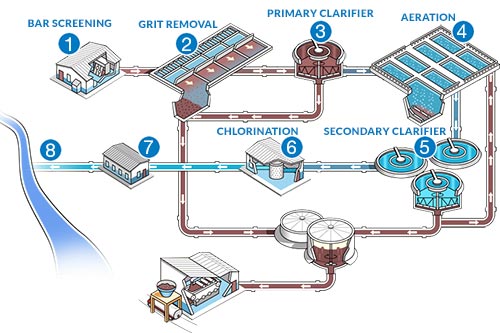Recognizing Wastewater Treatment Processes and Their Ecological Influence
The ins and outs of wastewater treatment procedures play a critical duty in mitigating environmental difficulties related to water air pollution. Each stage, from preliminary to innovative treatments, is made to deal with certain contaminants, eventually protecting both public wellness and aquatic communities. Nonetheless, in spite of technological advancements in therapy efficiency, considerable challenges continue, consisting of the monitoring of residual pollutants and the ramifications of nutrient drainage. As we check out the complexities of these processes, it ends up being necessary to wonder about how far current methodologies can evolve to meet the growing demands of sustainability and ecological conservation.
Summary of Wastewater Treatment
Exactly how is wastewater transformed into a safe resource for the atmosphere? Wastewater therapy is a crucial process designed to get rid of impurities from made use of water, therefore safeguarding public wellness and securing ecological communities. This procedure starts with the collection of wastewater from property, industrial, and business sources, which is after that guided to therapy centers.
At these facilities, various physical, chemical, and biological techniques are used to deal with the wastewater. Ultimately, organic treatments, such as triggered sludge processes, make use of microbes to damage down organic matter.
The dealt with effluent can be securely discharged right into natural water bodies or recycled for watering and commercial purposes, advertising source preservation. Furthermore, the treatment process produces biosolids, which can be repurposed as fertilizers or soil amendments, even more boosting sustainability.
Phases of Treatment Processes
The wastewater treatment procedure generally contains 3 main stages: preliminary, primary, and secondary therapy. Each phase serves a distinct role in minimizing the toxin load and guaranteeing the effluent satisfies ecological criteria prior to discharge.

The key treatment stage concentrates on the physical separation of suspended solids from the wastewater. With sedimentation, heavier bits resolve at the bottom of sedimentation storage tanks, creating sludge, while lighter materials, such as oils and oils, float to the surface and are skimmed. This procedure dramatically minimizes the organic and inorganic lots in the wastewater.
Second therapy is a biological process intended at more minimizing the focus of natural matter. This phase is essential for attaining the essential biochemical oxygen demand (BOD) decrease, eventually leading to cleaner effluent ready for discharge or more therapy.

Advanced Therapy Technologies
Following the second treatment procedures, advanced therapy technologies play an essential duty in further boosting the quality of dealt with wastewater. These innovations are designed to eliminate recurring pollutants that are not effectively gotten rid of throughout main and secondary treatments, ensuring the effluent fulfills stringent regulative standards.
Among the extensively utilized innovative treatment techniques are membrane layer filtration, reverse osmosis, and progressed oxidation procedures. Membrane purification, including microfiltration and ultrafiltration, works in dividing great fragments, microorganisms, and colloids from check my reference the water (Wastewater). Reverse osmosis makes use of semi-permeable membranes to eliminate liquified solids, resulting in high-grade water suitable for different applications
Advanced oxidation procedures (AOPs) use strong oxidants to deteriorate natural pollutants, including pharmaceuticals and individual care items that are resistant to conventional treatment. These techniques improve the biodegradability of intricate compounds, facilitating their removal.
Another substantial innovation is the usage of organic nutrient elimination procedures, which especially target nitrogen and phosphorus, protecting against eutrophication in obtaining water bodies. Overall, innovative therapy modern technologies are essential for achieving higher degrees of filtration, advertising water reuse, and guarding public wellness while resolving the obstacles related to wastewater administration.
Environmental Benefits of Therapy
Countless ecological benefits occur from effective wastewater treatment procedures that add to ecosystem wellness and sustainability. Mostly, these processes dramatically minimize the release of dangerous contaminants into natural water bodies, which aids preserve water environments. By eliminating contaminants such as hefty steels, nutrients, and microorganisms, treated wastewater mitigates the threat of waterborne conditions and advertises biodiversity in marine environments.
In addition, wastewater therapy facilities often use innovative modern technologies that allow water recycling and reuse. This practice not just saves freshwater resources yet additionally minimizes the demand on natural water products. Enhanced nutrient elimination from wastewater can likewise prevent eutrophication, a procedure that results in algal blossoms and subsequent oxygen depletion in marine systems.
Furthermore, reliable treatment procedures can reduce pop over to this web-site greenhouse gas emissions, especially methane and laughing gas, which are typically released throughout untreated wastewater disintegration. By capturing and using biogas from anaerobic digesters, centers can convert waste right into renewable resource, consequently contributing to a reduction in nonrenewable fuel source dependency.
Difficulties and Future Trends
While the ecological advantages of wastewater treatment are clear, a number of difficulties linger that hinder ideal end results in this field. One significant problem is maturing infrastructure, which commonly results in inadequacies and increased operational expenses - Wastewater. Several treatment plants were created years back, and their capacities do not straighten with modern demands, which consist of more stringent governing standards and higher quantities of wastewater as a result of urbanization

Looking ahead, there is an expanding focus on resource recuperation and circular economic situation principles within wastewater therapy. Advancements such as anaerobic digestion, which can generate biogas, and progressed filtration modern technologies are getting traction. These techniques not only boost treatment performance however additionally promote sustainability.
Ultimately, resolving these difficulties calls for partnership amongst stakeholders, investment in modern technology, and a commitment to recurring research study. By welcoming these patterns, the wastewater therapy industry can advance to you could try here meet the needs of a changing atmosphere and society.
Final Thought
In final thought, wastewater therapy procedures play a vital role in improving ecological top quality and public wellness. The multi-stage therapy framework, coupled with sophisticated innovations, properly mitigates contamination and advertises lasting water monitoring.